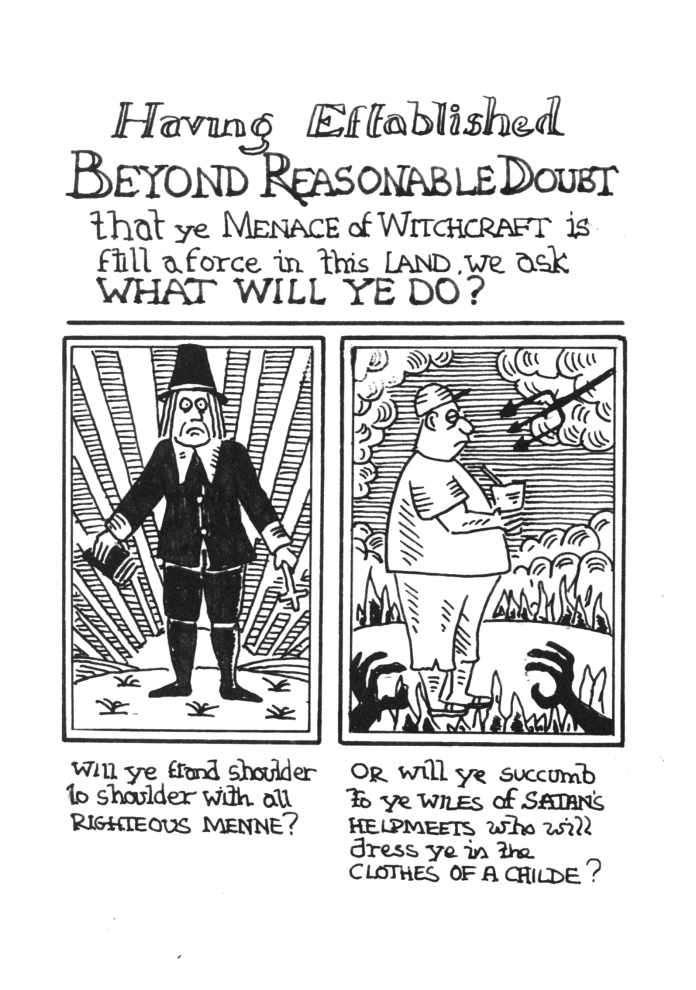From Varoom!, Spring 2014
I don’t know if the cartoonist’s love of certain situations could be called obsessive, but the countless numbers of jokes that have essentially the same drawing points in that direction. Pirates, desert islands, office desks and men hanging from chains in prison cells have been staples of cartooning since the Punch of the turn of the century or the New Yorker of the 20s. Those situations lend themselves to endlessly updated punchlines, but maybe there’s also a desire to do the perfect Pirate joke. Or, at least, this year’s perfect Pirate joke, probably involving Twitter or Miley Cyrus. Simon Meyrick-Jones, along with collaborator (or should that be co-conspirator?) Steve Way took the slightly less well-worn subject of Witchfinding out of the 17th Century and into the 21st. Their obsessive take on an obsessed character led to them creating an entire book. I asked Simon to illuminate the journey:
Materials: My everyday cartooning is done with a Pentel Stylo, which allows a left-handed person to utilise the variations in line that an ordinary pen gives to right-handed people. For the Witchfinder I used a variety of Rotring Art Pens and some children’s Back to School fountain pens from Tesco on cheap cartridge paper, in order to get a rough scratchy look.
Research: For years I’ve torn out and kept any images of 17th-century woodcuts. They just make me smile.
Process: I was collaborating with Steve Way on this. We’d decided on chapter headings and then both came up with ideas for each one which I’d then draw up in a woodcut style. I like collaborating with people; I think the results are usually funnier. Think of the endless jokes in the Airplane films, written by a team of writers, compared to the painfully thin Austin Powers films, written by just one person.
Resistances: The main problem was trying to explain to people what we were doing. Only a few people understood that Witchfinding was just the hook on which we were hanging explorations of sexism, bigotry, hypocrisy and religious myopia. The other problem was trying not to draw too quickly. Although it was really only a rough, it was important to keep the slow, stiff quality of the original woodcuts. Whereas in modern cartooning a certain looseness is what we’re looking for.
Insights: I’m almost ashamed to admit this, but after a while it dawned on me that 17-century woodcuts were the precursors of today’s cartoons; simply drawn figures with speech balloons and created for the mass market. They weren’t Fine Art, they were Graphic Art. Took me almost thirty years to realise that…
Distractions: Considering that it was really just a rough, it took ages to do, so after enough time, the alcoholic glow of our village pub proved too seductive. Though I’m not unhappy with that as I think that it’s important to spend time in the outside world not just inside one’s own thoughts. It’s the outside world that provides the ideas.
Numbers: I seem to know a disturbingly large amount of people who have the number 13 tattooed on them…
Obsession: Yes, it did become obsessive. Steve and I thought we’d get away with a few sample pages and a synopsis. Due to the incomprehension with which we met, we started to do a couple of pages for each chapter – and since that didn’t seem to help, we ended up doing the whole damned thing and having it made into a little book just to show people exactly what we meant, unfortunately with no success; though I was, and still am, convinced that it was a worthwhile and funny idea.




